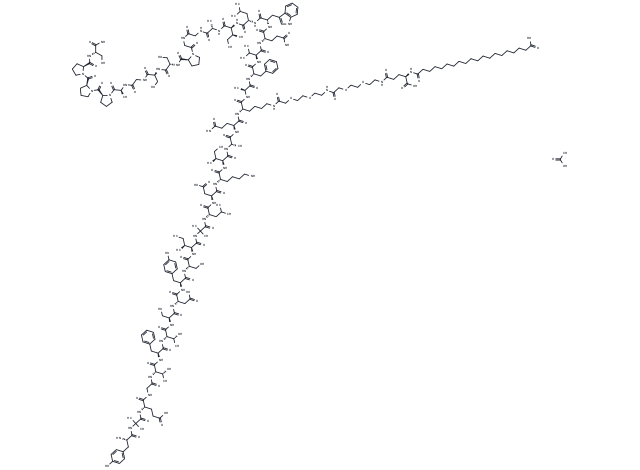Shopping Cart
- Remove All
 Your shopping cart is currently empty
Your shopping cart is currently empty

Tirzepatide (LY3298176) Acetate (2023788-19-2 free base) is a new molecule that can control blood glucose levels by combining dual agonism of glucose-dependent insulinotropic polypeptide (GIP) and glucagon-like peptide-1 (GLP-1) receptors.[3]

| Pack Size | Price | Availability | Quantity |
|---|---|---|---|
| 1 mg | $358 | In Stock | |
| 5 mg | $798 | In Stock | |
| 10 mg | $1,180 | In Stock | |
| 25 mg | $1,680 | In Stock |
| Description | Tirzepatide (LY3298176) Acetate (2023788-19-2 free base) is a new molecule that can control blood glucose levels by combining dual agonism of glucose-dependent insulinotropic polypeptide (GIP) and glucagon-like peptide-1 (GLP-1) receptors.[3] |
| In vitro | METHODS: Tirzepatide (LY3298176) (1, 3, 10, 30 nM) was used to treat GIPR or GLP-1R receptors, and Tirzepatide (30 μM, 30 nM) was used to treat cells expressing recombinant GIPR or GLP-1R to investigate whether it is effective on both GIPR and GLP-1R. RESULTS In receptor binding studies, LY3298176 had high affinity to either receptor (GIPR Ki = 0.135, SEM = 0.020 nM; GLP-1R Ki = 4.23, SEM = 0.23 nM); for GIPR, the affinity was comparable to that of native GIP, while for GLP-1R, the affinity was approximately 5-fold weaker than that of native GLP-1. In signaling studies using the same HER2 receptors, LY3298176 potently stimulated cAMP accumulation at either receptor (GIPR EC50 = 0.0224, SEM = 0.0053 nM; GLP-1R EC50 = 0.934, SEM = 0.068 nM).[1] METHODS: Representative confocal images of Tirzepatide (LY3298176)-induced receptor internalization and EGFP fluorescence in HA-GIPR-EGFP cells treated with Tirzepatide (LY3298176) (100 nM). RESULTS Tirzepatide (LY3298176) was weak in inducing internalization, resulting in a maximal effect of only 40% of that observed with GLP-1. Treatment with Tirzepatide (LY3298176) resulted in minimal reduction in cell surface labeling and only a slight increase in punctate localization of the receptor in the cytoplasmic/perinuclear region. [2] |
| In vivo | METHODS: Tirzepatide (LY3298176) (30nmol/kg,i.p) was used to evaluate in vivo glycemic control using an intraperitoneal glucose tolerance test (ipGTT) in normal and receptor-deficient mice. RESULTS Tirzepatide (LY3298176) enhanced insulin secretion in three pancreatic islet genotypes. Tirzepatide (LY3298176) can induce glucose-dependent insulin secretion in vivo through GIPR or GLP-1R and improve glucose tolerance in mice. [1] |
| Molecular Weight | 4873.5 |
| Formula | C227H352N48O70 |
| Smiles | C[C@H]([C@@H](C(N[C@H](C(N[C@H](C(N[C@H](C(N[C@H](C(N[C@H](C(N[C@H](C(N[C@H](C(NC(C)(C(N[C@H](C(N[C@H](C(N[C@H](C(N[C@H](C(N[C@H](C(N[C@H](C(N[C@H](C(N[C@H](C(N[C@H](C(N[C@H](C(N[C@H](C(N[C@H](C(N[C@H](C(N[C@H](C(N[C@H](C(NCC(NCC(N1CCC[C@H]1C(N[C@H](C(N[C@H](C(NCC(N[C@H](C(N2CCC[C@H]2C(N3CCC[C@H]3C(N4CCC[C@H]4C(N[C@H](C(N)=O)CO)=O)=O)=O)=O)C)=O)=O)CO)=O)CO)=O)=O)=O)=O)C)=O)[C@H](CC)C)=O)CC(C)C)=O)CC5=CNC6=C5C=CC=C6)=O)CCC(N)=O)=O)C(C)C)=O)CC7=CC=CC=C7)=O)C)=O)CCCCNC(COCCOCCNC(COCCOCCNC(CC[C@H](C(O)=O)NC(CCCCCCCCCCCCCCCCCCC(O)=O)=O)=O)=O)=O)=O)CCC(N)=O)=O)C)=O)[C@H](CC)C)=O)CCCCN)=O)CC(O)=O)=O)CC(C)C)=O)C)=O)[C@H](CC)C)=O)CO)=O)CC8=CC=C(O)C=C8)=O)CC(O)=O)=O)CO)=O)[C@H](O)C)=O)CC9=CC=CC=C9)=O)NC(CNC([C@@H](NC(C(C)(NC([C@H](CC%10=CC=C(O)C=C%10)N)=O)C)=O)CCC(O)=O)=O)=O)O.CC(O)=O |
| Relative Density. | no data available |
| Storage | keep away from moisture | Powder: -20°C for 3 years | In solvent: -80°C for 1 year | Shipping with blue ice. |
| Solubility Information | H2O: <1 mg/mL |

Copyright © 2015-2025 TargetMol Chemicals Inc. All Rights Reserved.